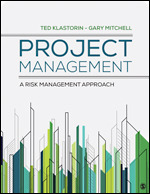Foreword
Preface
Acknowledgments
About the Authors
Chapter 1. An Introduction to Project Management
1.2 What Defines a Project?
1.3 The Project Life Cycle
1.4 Measures of Project Success and Failure
1.5 Managing Project Risks
1.6 Project Management Trade-Offs
1.7 Program Versus Project Management
1.8 Agile Project Management: A Modern Development
1.9 A Brief History of Project Management
1.10 Overview of the Text
Chapter 2. Project Initiation and Selection
2.2 The Relationship of Projects to Strategic and Operational Goals
2.3 Simple Numerical Measures
2.5 Implementing “Options Thinking”
2.6 “Stage Gates” Defined
2.7 Ranking and Scoring Methods
2.8 Evaluating Project Portfolios
Chapter 3. Project Planning
3.2 Outline of a Project Plan
3.3 Risk Management Strategy and Plan
3.4 Communications Strategy and Plan
3.5 Identifying Project Requirements
Chapter 3S. Supplement: Agile Project Management
3S.2 Agile Project Management
3S.3 Implementing Agile PM
3S.4 Scrum and Extreme Programming
3S.5 Velocity and Burndown Charts
3S.6 Risk Management and the Agile–Traditional Continuum
3S.7 Agile PM Analogy: American Football
Chapter 4. Defining Project Content
4.3 Defining Project Work
4.4 Estimating Work Content and Task Duration
4.5 Deterministic Versus Stochastic Estimates
4.6 Common Pitfalls and Perils
Chapter 4S. Supplement: Review of Probability and Distribution Functions
4S.2 Probability Distributions
4S.3 Summary Measures for Probability Distributions
4S.4 Common Discrete Distributions
4S.5 Common Continuous Distributions
4S.6 Sums of Random Variables
Chapter 5. Scheduling a Deterministic Project
5.2 Determining a Project’s Schedule
5.3 The Critical Path Method
5.4 Calculating Slacks (Floats)
5.5 Types of Precedence Relations
5.6 Linear Programming Formulation
5.7 Gantt Charts: Representing the Schedule Graphically
5.8 Activity-on-Arc Precedence Networks
5.9 A Note Regarding Software Programs
Chapter 6. Project Trade-Offs and Risk Mitigation
6.2 Preparing a Budget: The Basic Time–Cost Relationship
6.3 Project Compression: Time–Cost Trade-Offs
6.4 Risk Management and Time–Cost Trade-Offs
6.5 Time–Cost Trade-Offs in Stochastic Projects
6.6 Other Trade-Off Issues: Concurrent Engineering and Coordination Costs
Chapter 7. Scheduling Stochastic Projects
7.2 Proactive Versus Reactive Scheduling
7.3 Using Buffers to Protect the Schedule
7.4 Planning Under Task Time Uncertainty Using Classic PERT
7.5 Planning Under Task Time Uncertainty Using Monte Carlo Simulation Models
7.6 Managing Exogenous Uncertainties
7.7 Task Time Uncertainty and the Theory of Constraints
Chapter 7S. Supplement: Monte Carlo Simulation
7S.3 Generating Random Variates
7S.5 Analyzing the Simulation
Chapter 8. Managing Project Resources
8.2 Defining Resource Types
8.3 Criteria for Scheduling Resource Types
8.4 The Resource Leveling Problem Defined
8.5 The Rate-Constrained Resource Allocation Problem
8.6 Heuristics for the Rate-Constrained Resource Allocation Problem
8.7 An Easily Solvable Rate-Constrained Resource Allocation Problem: The Critical Chain Defined
8.8 The Critical Chain Methodology
8.9 Defining Resource Buffers
8.10 Capacity-Constrained Resource Allocation
8.11 Supply Chain Management and Projects
8.12 Impact of Worker Behaviors on Project Outcomes
Chapter 9. Project Teams
9.2 Forming a Project Team
9.3 Assigning Potential Team Members to a Project
9.4 Making Trade-Off Decisions When Creating Project Teams
9.5 Determining Team Size When Resource Availability Is Uncertain
9.6 Managing the Project Team
9.7 Managing the End of Project Transition
Chapter 10. Managing Decentralized Projects
10.2 Decentralized Projects
10.3 Subcontracting Issues Defined
10.4 Underlying Economic Concepts
10.5 Contract Types Defined
10.6 Defining a Contract That Maximizes the Project Value
Chapter 11. Assessing Project Progress
11.2 Assessing In-Control Versus Out-of-Control Project States
11.3 Earned Value Analysis Defined
11.4 Limitations of Earned Value Analysis
11.5 Updating Cost and Schedule Forecasts
Chapter 12. Managing a Multiproject Environment
12.2 Managing the Project Portfolio
12.3 Ensuring Projects Deliver Their Value Propositions
12.4 The Role of the Project Manager
Appendix A: Textbook Notations Defined
Appendix B: MS Project Practice Problems
Glossary
Bibliography
Index
